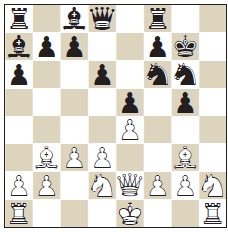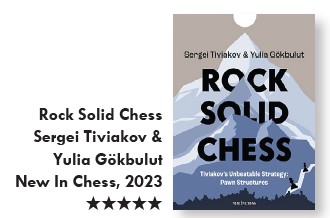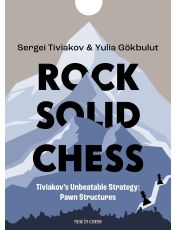
Sadler on Books (2023#4)
This book review by Matthew Sadler was published in New In Chess magazine 2023#4
I was chatting with Michael Adams recently during a dinner and we started to discuss the process of analysing positions with engines and annotating games. He made the funny but very astute observation that what engines say is often not very useful but unfortunately you can’t ignore what they say either, so you end up not really knowing what to do! For example, you ideally want to generalise key moments in game annotations to provide the reader with knowledge that can be reused in subsequent games. Engines have a way of crossing this goal, most often by highlighting a series of specific exceptions to the narrative you are trying to build. It can cost a substantial amount of effort to discover the reason a specific exception works...and then you still need to figure out how to explain this succinctly to your readers, or whether it’s even possible without confusing them! Ideally, tools should simplify your work, but engines – even for the highest-level players – can complicate as much as they help!
For all that, I remain very positive about the value of chess engines in chess improvement, but I think it’s clear that working optimally with engines requires more subtlety and thought than you might expect.
From that point of view, I would recommend the introductory chapter of Sergei Tiviakov’s & Yulia Gökbulut’s Rock Solid Chess (New In Chess) to everyone to read. The chapter is entitled ‘Human chess versus computer chess’ and was apparently added to the book after some feedback on the original manuscript. I’m somewhat intrigued as to the nature of this feedback as the rest seemed excellent to me anyway, but the chapter definitely adds an extra dimension to the book. Sergei runs through a series of positions in which an engine discovers hidden possibilities or improves on human play, and gives his opinion on which are valuable for human learning – and how to make use of them – and which should be put aside.
Interestingly, this last category includes a typical Italian game position from one of Sergei’s games:
Sergei Tiviakov
Gilberto Milos
Tromsø Olympiad 2014
1.e4 e5 2.♘f3 ♘c6 3.♗c4 ♗c5 4.c3 ♘f6 5.d3 a6 6.♗b3 ♗a7 7.h3 0-0 8.♗g5 d6 9.♘h2 h6 10.♗h4 g5 11.♗g3 ♘e7 12.h4 ♘g6 13.hxg5 hxg5 14.♘d2 ♔g7 15.♕e2 Sergei’s comments are worth quoting in full: ‘Question: What are the human and computer assessments of the position? As far as I’m concerned, White has the advantage: it’s easier for him to play. But the computer, you will be surprised, goes for Black. It is not embarrassed by serious pawn defects in the position, weakened squares, as well as pawn thrusts which have exposed its own king, like 10...g5. For it, this is absolutely normal play. The engine’s defence is based on dynamics, on specific move-by-move play. It is extremely difficult for a human to play such positions. You should consider this when preparing for an opponent.’
Sergei’s comments are worth quoting in full: ‘Question: What are the human and computer assessments of the position? As far as I’m concerned, White has the advantage: it’s easier for him to play. But the computer, you will be surprised, goes for Black. It is not embarrassed by serious pawn defects in the position, weakened squares, as well as pawn thrusts which have exposed its own king, like 10...g5. For it, this is absolutely normal play. The engine’s defence is based on dynamics, on specific move-by-move play. It is extremely difficult for a human to play such positions. You should consider this when preparing for an opponent.’
And indeed, Sergei won a game in which an engine-free glance would not detect anything else than a slight Black disadvantage from this position on!
I loved this chapter as an exposition of how an understanding of engines’ play can broaden your game – either by opening your mind to generalisable possibilities of which you had not dreamt, or by allowing you to ignore engine evaluations which would require an elevated level of accuracy from your opponents which they could never sustain!
It’s obviously natural for me to focus on the chapter that intersects with my chess passion at the moment, but that wouldn’t do justice to the rest of the book, which is excellent too.
Anyone who has prepared for Sergei can’t help but be struck at the number of systems he played that scorned conventional evaluation. Many of his White systems – for example against the French, Sicilian and Caro-Kann – aimed for a simple structure (such as 3 vs 2 on the queenside), which he then exploited to perfection through superior understanding. He was the type of player – Michael Adams is another – who made you nervous about heading for supposedly ‘equal’ positions out of the opening against them! Quite appropriately, the book’s seven chapters are organised around typical structures that Sergei reached in his games. Of these, the very first – ‘Pawn majority on one flank’ – is my favourite, containing opening, middlegame and endgame insights on the pawn structures that have been Sergei’s bread and butter throughout his whole career.
Quite appropriately, the book’s seven chapters are organised around typical structures that Sergei reached in his games. Of these, the very first – ‘Pawn majority on one flank’ – is my favourite, containing opening, middlegame and endgame insights on the pawn structures that have been Sergei’s bread and butter throughout his whole career.
It’s a really excellent book, not heavy in variations, easy to read and full of advanced but well-formulated advice. I’d recommend it unreservedly to any (young) player who wishes to enrich their understanding of the game. Five well-deserved stars!

